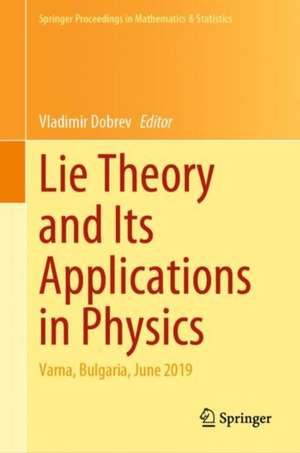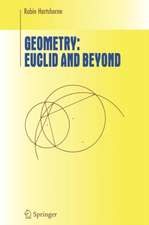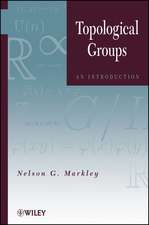Lie Theory and Its Applications in Physics: Varna, Bulgaria, June 2019: Springer Proceedings in Mathematics & Statistics, cartea 335
Editat de Vladimir Dobreven Limba Engleză Hardback – 16 oct 2020
Traditionally, Lie theory is a tool to build mathematical models for physical systems. Recently, the trend is towards geometrization of the mathematical description of physical systems and objects. A geometric approach to a system yields in general some notion of symmetry, which is very helpful in understanding its structure. Geometrization and symmetries are meant in their widest sense, i.e., representation theory, algebraic geometry, number theory, infinite-dimensional Lie algebras and groups, superalgebras and supergroups, groups and quantum groups, noncommutative geometry, symmetries of linear and nonlinear partial differential operators, special functions, and others. Furthermore, the necessary tools from functional analysis are included.This is a large interdisciplinary and interrelated field.
The topics covered in this volume from the workshop represent the most modern trends in the field : Representation Theory, Symmetries in String Theories, Symmetries in Gravity Theories, Supergravity, Conformal Field Theory, Integrable Systems, Polylogarithms, and Supersymmetry. They also include Supersymmetric Calogero-type models, Quantum Groups, Deformations, Quantum Computing and Deep Learning, Entanglement, Applications to Quantum Theory, and Exceptional Quantum Algebra for the standard model of particle physics
This book is suitable for a broad audience of mathematicians, mathematical physicists, and theoretical physicists, including researchers and graduate students interested in Lie Theory.
| Toate formatele și edițiile | Preț | Express |
|---|---|---|
| Paperback (5) | 957.32 lei 6-8 săpt. | |
| Springer Nature Singapore – 17 oct 2021 | 957.32 lei 6-8 săpt. | |
| Springer – 20 mai 2015 | 957.44 lei 6-8 săpt. | |
| Springer – 6 oct 2016 | 958.25 lei 6-8 săpt. | |
| Springer Nature Singapore – 5 iul 2018 | 1232.57 lei 6-8 săpt. | |
| Springer Nature Singapore – 2 feb 2024 | 1392.65 lei 6-8 săpt. | |
| Hardback (5) | 821.40 lei 38-45 zile | |
| Springer Nature Singapore – feb 2023 | 1401.93 lei 3-5 săpt. | |
| Springer Nature Singapore – 16 oct 2020 | 821.40 lei 38-45 zile | |
| Springer – 19 apr 2013 | 963.77 lei 6-8 săpt. | |
| Springer – 6 feb 2015 | 964.54 lei 6-8 săpt. | |
| Springer Nature Singapore – 11 dec 2016 | 1238.86 lei 6-8 săpt. |
Din seria Springer Proceedings in Mathematics & Statistics
- 15%
 Preț: 642.03 lei
Preț: 642.03 lei - 15%
 Preț: 646.62 lei
Preț: 646.62 lei - 18%
 Preț: 727.31 lei
Preț: 727.31 lei - 24%
 Preț: 1236.82 lei
Preț: 1236.82 lei - 18%
 Preț: 727.97 lei
Preț: 727.97 lei - 18%
 Preț: 1016.01 lei
Preț: 1016.01 lei - 15%
 Preț: 656.43 lei
Preț: 656.43 lei - 18%
 Preț: 947.35 lei
Preț: 947.35 lei - 15%
 Preț: 646.62 lei
Preț: 646.62 lei - 18%
 Preț: 948.92 lei
Preț: 948.92 lei - 18%
 Preț: 1699.47 lei
Preț: 1699.47 lei - 18%
 Preț: 1120.18 lei
Preț: 1120.18 lei - 15%
 Preț: 644.95 lei
Preț: 644.95 lei - 18%
 Preț: 1233.83 lei
Preț: 1233.83 lei - 18%
 Preț: 1120.18 lei
Preț: 1120.18 lei - 18%
 Preț: 1033.37 lei
Preț: 1033.37 lei - 18%
 Preț: 948.92 lei
Preț: 948.92 lei - 18%
 Preț: 896.08 lei
Preț: 896.08 lei - 18%
 Preț: 1115.46 lei
Preț: 1115.46 lei - 18%
 Preț: 952.09 lei
Preț: 952.09 lei - 18%
 Preț: 1230.66 lei
Preț: 1230.66 lei - 15%
 Preț: 647.59 lei
Preț: 647.59 lei - 18%
 Preț: 1124.92 lei
Preț: 1124.92 lei - 20%
 Preț: 1630.95 lei
Preț: 1630.95 lei - 18%
 Preț: 1123.35 lei
Preț: 1123.35 lei - 18%
 Preț: 950.52 lei
Preț: 950.52 lei - 18%
 Preț: 947.35 lei
Preț: 947.35 lei - 18%
 Preț: 1003.70 lei
Preț: 1003.70 lei - 18%
 Preț: 956.81 lei
Preț: 956.81 lei - 18%
 Preț: 889.75 lei
Preț: 889.75 lei - 18%
 Preț: 1000.24 lei
Preț: 1000.24 lei - 18%
 Preț: 1122.56 lei
Preț: 1122.56 lei - 18%
 Preț: 1005.74 lei
Preț: 1005.74 lei - 18%
 Preț: 950.96 lei
Preț: 950.96 lei - 18%
 Preț: 1009.08 lei
Preț: 1009.08 lei - 18%
 Preț: 1008.91 lei
Preț: 1008.91 lei - 18%
 Preț: 947.35 lei
Preț: 947.35 lei - 18%
 Preț: 1113.89 lei
Preț: 1113.89 lei - 18%
 Preț: 1113.71 lei
Preț: 1113.71 lei - 18%
 Preț: 1400.35 lei
Preț: 1400.35 lei - 18%
 Preț: 969.44 lei
Preț: 969.44 lei - 18%
 Preț: 1401.93 lei
Preț: 1401.93 lei - 18%
 Preț: 948.92 lei
Preț: 948.92 lei - 18%
 Preț: 1392.46 lei
Preț: 1392.46 lei - 20%
 Preț: 878.66 lei
Preț: 878.66 lei - 20%
 Preț: 1002.90 lei
Preț: 1002.90 lei - 18%
 Preț: 1120.99 lei
Preț: 1120.99 lei - 18%
 Preț: 942.63 lei
Preț: 942.63 lei - 18%
 Preț: 1113.09 lei
Preț: 1113.09 lei
Preț: 821.40 lei
Preț vechi: 1080.80 lei
-24% Nou
Puncte Express: 1232
Preț estimativ în valută:
157.19€ • 163.90$ • 130.64£
157.19€ • 163.90$ • 130.64£
Carte tipărită la comandă
Livrare economică 17-24 martie
Preluare comenzi: 021 569.72.76
Specificații
ISBN-13: 9789811577741
ISBN-10: 9811577749
Pagini: 552
Ilustrații: XIV, 552 p. 109 illus., 38 illus. in color.
Dimensiuni: 155 x 235 mm
Greutate: 1.04 kg
Ediția:1st ed. 2020
Editura: Springer Nature Singapore
Colecția Springer
Seria Springer Proceedings in Mathematics & Statistics
Locul publicării:Singapore, Singapore
ISBN-10: 9811577749
Pagini: 552
Ilustrații: XIV, 552 p. 109 illus., 38 illus. in color.
Dimensiuni: 155 x 235 mm
Greutate: 1.04 kg
Ediția:1st ed. 2020
Editura: Springer Nature Singapore
Colecția Springer
Seria Springer Proceedings in Mathematics & Statistics
Locul publicării:Singapore, Singapore
Cuprins
1 PlenaryTalks, T. Kobayashi, Topics on global analysis of manifolds and representation theory of reductive groups.- T. Kobayashi and B. Speh, A hidden symmetry of a branching law.- I. Todorov, Exceptional quantum algebra for the standard model of particle physics.- M. de Leeuw, B. Eden, D. le Plat, and T. Meier, Polylogarithms from the bound state S-matrix.- M. Henkel and S. Stoimenov, Meta-conformal invariance and their covariant correlation functions.- I. L. Buchbinder, S. Fedoruk, A.P. Isaev, Infinite spin particles and super particles.- E. Ivanov, Supersymmetric Calogero-type models via gauging in superspace.- I. Kostov, The Octagon form factor in N = 4SYM and free fermions.- P. Phillips and G. La Nave, Nother’s second theorem as an obstruction to charge quantization.- G. W. Semenoff, Entanglement and the Infrared.- A.V. Smilga, Comments on the Newlander-Nirenberg theorem.- N.I. Stoilova and J. Van der Jeugt, A class of representations of the orthosymplectic Lie superalgebras B(n,n) and B(∞,∞).- K. Yoshida, Recent progress on Yang-Baxter deformation and generalized supergravity.- G. Manolakos, P. Manousselis and G. Zoupanos, Gauge Theories on Fuzzy Spaces and Gravity.- String Theories and Gravity Theories, D. Benisty, E. Guendelman, A. Kaganovich, E. Nissimov, and S. Pacheva, Modified Gravity Theories Based on the Non-Canonical Volume-Form Formalism.- A. Marrani, Non-linear symmetries in Maxwell-Einstein gravity:from Freudenthal duality to pre-homogeneous vector spaces.- H. Partouche and B. de Vaulchier, Phase transitions at high supersymmetry breaking scale in string theory.- F. Riccioni, Exotic branes and exotic dualities in supergravity.- H. Dimov, R.C. Rashkov and T. Vetsov, Thermodynamic information geometry and applications in holography.- D. Staicova, The role of the slope in the multi-measure cosmological model.- D. Benisty, E.I. Guendelman and J. Struckmeier, Gauge theory of gravity based on the correspondence between the 1st and the 2nd order formalisms.- 3 IntegrableSystems, C. Burdik and O. Navratil, Nested Bethe Ansatz for RTT–algebra of Uq(sp(2n)) type.- O. Vaneeva, O. Magda and A. Zhalij, Equivalence groupoid and enhanced group classification of a class of generalized Kawahara equations.- C. Rim, Interplay between minimal gravity and intersection theory.- Y. Ohkubo, Generalized Macdonald functions, AGT correspondence and intertwiners of DIM algebra.- 4 Representation Theory, W. M. McGovern, Closures of K-orbits in the flag variety for Sp(2n,R).- I. Smilga, Action of the restricted Weyl group on the L-invariant vectors of a representation.- E. Ongong’a, J. Ongaro, S. Silvestrov, Hom-Lie structures on complex 4-dimensional Lie algebras.- V.K. Dobrev, Multiplet classification and invariant differential operators over the Lie algebra F′4.- A. Langlois-Remillard and R. Oste, An exceptional symmetry algebra for the 3D Dirac–Dunkl operator.- J. Hrivnak and L. Motlochova, Graphene dots via discretizations of Weyl-orbit functions.- T. Hayashi, A construction of (g,K)-modules over commutative rings.- I. Barza and D. Ghisa, Lie groups actions on non orientable Klein surface.- 5 Quantum Groups and Deformations, T. Popov, Quantum diagonal algebra and pseudo-plactic algebra.- M. Nesterenko and S. Posta, Contractions of realizations.- P. Back, Multi-parameter formal deformations of ternary hom-Nambu-Lie algebras.- 6 Applications to Quantum Theory, S. Stoimenov and M. Henkel, Meta-conformal invariance in the directed Glauber-Ising chain.- I. Salom and V. Dmitrasinovic, Relativistic three-body harmonic oscillator.- J. Mashford, An introduction to spectral regularization for quantum field theory.- M. Hewitt, Relative quantum states, observations and moduli stacks.- M. Blasone, P. Jizba and L. Smaldone, Dynamical generation of flavour vacuum.- O.C. Stoica, A representation of the wave-function on 3-dimensional space.- Various Mathematical Results, J. Fullwood, On a Grothendieck-Brieskorn relation for elliptic Calabi-Yaus.- A. Ganchev, Control and composability in deep learning -brief overview by a learner.- C. Anghel, N. Buruiana and D. Cheptea, Lie theory and infinitesimal extensions in algebraic geometry.- J. Ecker, The low-dimensional algebraic cohomology of the Witt and the Virasoro algebra with values in general tensor densities modules.- P. Benito and J. Roldan-Lopez, Derivations and automorphisms of free nilpotent Lie algebras and their quotients.
Textul de pe ultima copertă
This volume presents modern trends in the area of symmetries and their applications based on contributions to the workshop "Lie Theory and Its Applications in Physics" held near Varna (Bulgaria) in June 2019.
Traditionally, Lie theory is a tool to build mathematical models for physical systems. Recently, the trend is towards geometrization of the mathematical description of physical systems and objects. A geometric approach to a system yields in general some notion of symmetry, which is very helpful in understanding its structure. Geometrization and symmetries are meant in their widest sense, i.e., representation theory, algebraic geometry, number theory, infinite-dimensional Lie algebras and groups, superalgebras and supergroups, groups and quantum groups, noncommutative geometry, symmetries of linear and nonlinear partial differential operators, special functions, and others. Furthermore, the necessary tools from functional analysis are included.This is a large interdisciplinary and interrelated field.
The topics covered in this volume from the workshop represent the most modern trends in the field : Representation Theory, Symmetries in String Theories, Symmetries in Gravity Theories, Supergravity, Conformal Field Theory, Integrable Systems, Polylogarithms, and Supersymmetry. They also include Supersymmetric Calogero-type models, Quantum Groups, Deformations, Quantum Computing and Deep Learning, Entanglement, Applications to Quantum Theory, and Exceptional Quantum Algebra for the standard model of particle physics
This book is suitable for a broad audience of mathematicians, mathematical physicists, and theoretical physicists, including researchers and graduate students interested in Lie Theory.
Caracteristici
Presents a unique balanced representation of mathematicians, mathematical physicists, and theoretical physicists Serves as interface of the scientific interests and methods of these groups of scientists Covers the entire field of Lie Theory in its widest sense, with its applications in many diverse facets of physics






















